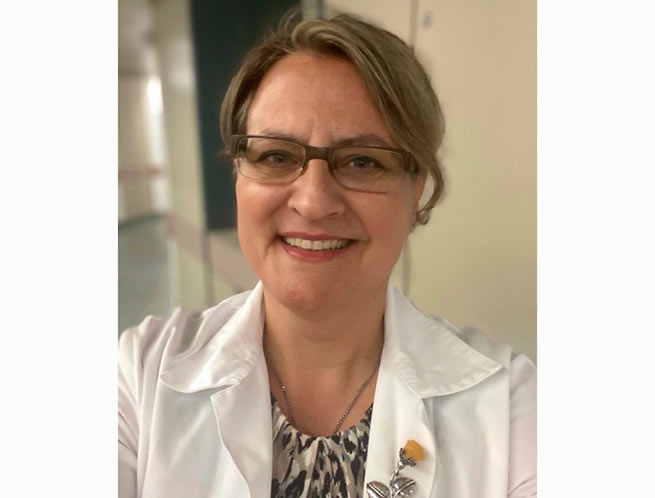Even the most aggressive breast cancer can now be effectively treated using the latest methods if diagnosed at an early stage, says oncologist Dimitra Kanalupiti.
Effective treatment
Breast cancer is curable even if it has spread to the lymph nodes, and if it has metastasized to other parts of the body, it can become a chronic disease with treatment and monitoring.
Moreover, specialists are currently studying the possibilities of the most effective treatment in each specific case with minimal intervention so that the desired result is achieved with the least side effects.
With all this, progress has been made possible thanks to the latest innovative treatment methods, in which target-seeking drugs, i.e. a cancerous tumor is attacked and destroyed without damaging surrounding tissues, but also without exposing the patient to the unpleasant consequences of chemotherapy. In addition, these methods allow for minimal surgical intervention, as a result of which in most cases it is possible to preserve the mammary gland.
When it comes to lymph node involvement, it used to be that all the lymph nodes were removed, resulting in lymphedema, but now by removing one or two lymph nodes (the sentinel nodes), the problem can be effectively treated without unpleasant side effects.

Oncologist Ms. Dimitra Kanalupiti
In.gr talked about all of the above with Ms. Dimitra Kanalupiti, pathologist-oncologist, director of the 4th IASO Oncology Clinic, since October is dedicated to breast cancer, focusing on the latest advances, especially regarding the most aggressive form of the disease – triple negative breast cancer .
“Modern breast cancer therapy is now trying to de-escalate all treatments, but this does not mean less aggressive treatment.
The goal is shorter operations, and the current trend is to resection only the tumor, and only in some cases mastectomy if the tumor is large, if the breast is too small or if there are multiple lesions. In addition, with newer techniques, most cases require the removal of a small number of lymph nodes to determine the extent of the disease to avoid significant postoperative morbidity.
In addition, studies are being conducted to examine the possibility of avoiding surgery or radiation therapy, since in some cases the disease is completely eradicated after preoperative treatment.
De-escalation even extends to chemotherapy, continually identifying patients who do not need chemotherapy at all or who would benefit from milder treatment. If we have an equally effective regimen with fewer side effects, then we will go for it,” she says.
Causes
Breast cancer is very common, affecting 1 in 8 women, or 12% of women.
The risk increases with a family history or genetic syndromes – pathogenic mutations that are passed down from generation to generation and predispose to various types of cancer, including breast cancer, for example, the BRCA1 gene and others.
“The more we study, the more pathogenic mutations we identify. They are very important genetic information because they tell us how to monitor patients who carry them and what preventative measures to take,” Kanalupiti said.
Among the risk factors, she added, there are both those that can be changed, for example, taking estrogen, obesity, lack of physical activity, and those that cannot be changed, for example, the age of onset of menstruation, the presence or absence of children, the age of menopause and hereditary peculiarities. Environmental factors are also important, meaning what we eat and drink, and even the air we breathe, certainly have an impact.
“Lifestyle influences the risk of developing breast cancer. The risk in the Western world is 7 times higher than in Asian countries. But it is characteristic that, for example, people migrating from Japan or China to the United States after two generations have the same risk as do the local population, which suggests that both genetic and environmental factors coexist and shape risk,” Ms Kanalupiti concluded.
Types of breast cancer
Breast cancer is divided into three main types:
- Hormone dependent, in which cancer cells feed on estrogen produced in our body. When their receptor or source is blocked, they starve and die.
- HER2-positive, in which the receptor of the same name, responsible for cell proliferation, is hyperactive and constantly sends a signal to cancer cells to reproduce. We stop this with receptor inhibitors.
- In triple negative, when the cancer is negative for estrogen, progesterone and HER2, that is why it is called triple negative. This cancer is inherently more aggressive, it exhibits poor biological behavior and rapid growth rates, a higher risk of recurrence and metastasis, and it is precisely because it is triple negative that some targeted therapies are the “weapons” that we have for other breast cancers. glands don’t work. Therefore, until recently, we used only chemotherapy. But, fortunately, this is only 10-20% of breast cancer cases.
Triple negative breast cancer most often occurs in young people (under 50 years of age). All patients with triple negative breast cancer undergo gene testing in their blood and most often carry pathogenic mutations (eg, BRCA 1 and 2). Since these mutations have a 50% chance of being inherited in offspring, their detection is important not only for patients but also for their families, as it changes the way they are monitored if they carry the mutation with more frequent and more specific testing.
Ms. Kanalupiti noted that there is often fear and people do not go for genetic testing, but she emphasized that genetic information is not a disease, it is information that you use to protect yourself. That’s why all women with triple-negative breast cancer, even those over 80 years old, should get genetic testing so they have more treatment options themselves and to protect their family members.
Early diagnosis
She also touched on the importance of early diagnosis, saying that it is important for all types of cancer, emphasizing that breast cancer up to the third stage, before it has reached distant metastases to other organs, has the potential to be cured. Once it becomes metastatic, the focus is to ensure that the disease becomes chronic so that patients can live a quality and functional life.
Treatment methods
“In terms of treatment, things are looking good for triple-negative breast cancer, for which until now we only had the option of chemotherapy,” says Kanalupiti.
We have very encouraging news because immunotherapy – drugs that boost the immune system so that it recognizes cancer cells as foreign and attacks them – has been added to treatment options. It is important that it does not have the side effects of chemotherapy, so even people with hypertension can be treated. Immunotherapy was first tested in the metastatic stage, but is now also used in some cases in the treatment of early cancer, as it reduces the risk of disease recurrence. This, combined with surgery, chemotherapy and radiotherapy, widens the window of opportunity for recovery and more patients are cured.
Other treatments for breast cancer include targeted therapy with parp inhibitors, which act like supplements to inhibit the repair of damage to the genetic code (DNA) of cancer cells, leading to their death.
Smart medicines
However, so-called “smart drugs” have recently been approved, which are monoclonal antibodies such as sassituzimab that target only cancer cells, leaving healthy tissue largely untouched. This drug is approved for the treatment of triple-negative breast cancer, and it provides much greater benefits than standard chemotherapy because it delivers a very large load to the cancer cell without much damage to normal tissue.







More Stories
Magnesium-rich foods that also protect against cancer
Toothpaste causes cancer
Myth: The perfect body for summer